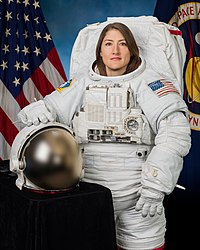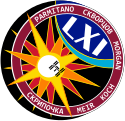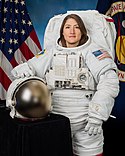Christina Koch
| Christina Hammock Koch | |
|---|---|
 | |
| Land | |
| Organisation | |
| ausgewählt | 17. Juni 2013 (21. NASA-Gruppe) |
| Einsätze | 1 Raumflug |
| Start | 14. März 2019 |
| Landung | 6. Februar 2020 |
| Zeit im Weltraum | 328d 13h 58m |
| EVA-Einsätze | 5 |
| EVA-Gesamtdauer | ca. 43 h |
| Raumflüge | |
Christina Hammock Koch (* 29. Januar 1979 in Grand Rapids, Michigan als Christina Hammock) ist eine US-amerikanische Astronautin. Am 14. März 2019 flog sie zur ISS, wo sie an den drei Langzeitexpeditionen 59 bis 61 teilnahm. Die Mission dauerte insgesamt 328 Tage; damit ist Hammock Koch die Frau mit dem bislang längsten Weltraumaufenthalt. In der historischen Rangliste der längsten Raumflüge belegt sie den 9. Platz.
Leben
Christina Hammock Koch studierte an der North Carolina State University in Raleigh und erwarb dort je einen Bachelor-Abschluss in Physik und Elektrotechnik sowie im Anschluss einen Master in Elektrotechnik. Sie arbeitete als Elektroingenieurin am Labor für Hochenergie-Astrophysik des NASA Goddard Space Flight Centers. Von 2004 bis 2007 war sie wissenschaftliche Mitarbeiterin im Antarktis-Programm der Vereinigten Staaten. Im Rahmen dessen verbrachte sie eine Wintersaison auf der Amundsen-Scott-Südpolstation und eine weitere Saison auf der Palmer-Station. Von 2007 bis 2009 war Koch als Elektroingenieurin im Bereich Raumfahrt-Instrumentenentwicklung an der Johns-Hopkins-Universität tätig. Im Jahr 2010 kehrte sie zur Feldforschung zurück an die Palmer-Station in der Antarktis sowie mehreren Winteraufenthalte an der Summit-Station in Grönland. 2012 setzte Koch bei der National Oceanic and Atmospheric Administration (NOAA) ihre Arbeit an abgelegenen Stützpunkten fort. Sie war als Feldingenieurin im Observatorium der Global Monitoring Division des NOAA in Barrow (Alaska) und später als Stationsleiterin des Observatoriums in Amerikanisch-Samoa tätig.[1]
Astronautentätigkeit
Koch wurde am 17. Juni 2013 als Mitglied der NASA-Astronautengruppe 21 ausgewählt.[2]
Am 15. März 2019 erreichte sie als Mitglied der Sojus-MS-12-Besatzung die ISS. Ursprünglich war vorgesehen, dass sie als Bordingenieurin an den Langzeitmissionen Expedition 59 und Expedition 60 teilnimmt, was in etwa einem Aufenthalt von einem halben Jahr entspricht. Wegen Verzögerungen bei der Fertigstellung der neuen US-Raumschiffe Crew Dragon und CST-100 Starliner wurde ihr geplanter Aufenthalt jedoch auf die Expedition 61 ausgeweitet, die zusätzlich noch verlängert wurde. Dies entspricht einer Aufenthaltsdauer von insgesamt elf Monaten.[3][4] Am 6. Februar 2020 kehrte Koch mit Sojus MS-13 zur Erde zurück.

Während ihres ISS-Aufenthalts unternahm Koch mehrere Außenbordeinsätze für Wartungsarbeiten an der Stromversorgung der Station. Ihren ersten Weltraumausstieg absolvierte sie gemeinsam mit Nick Hague am 22. März 2019, den zweiten mit Andrew Morgan am 6. Oktober. Die beiden Einsätze dauerten jeweils rund sieben Stunden. Ein dritter am 18. Oktober 2019 gemeinsam mit Jessica Meir erregte große Aufmerksamkeit, da zum ersten Mal ein rein weibliches Team im Außeneinsatz war. Der Einsatz dauerte sieben Stunden und 17 Minuten, einschließlich einer kurzen Live-Fernsehschaltung zu US-Präsident Donald Trump und Vizepräsident Mike Pence.[5][6]
Im Dezember 2019 stellte Koch den vorherigen Weltrekord für einen durchgehenden Aufenthalt einer Frau im All ein und überbot ihn in der Folge mit 328 Tagen. Die US-Astronautin Peggy Whitson hatte ihn zuvor mit 289 Tage im ISS-Einsatz (2016/17) gehalten.[7] Koch erreichte damit auch den zweitlängsten Aufenthalt eines US-Astronauten im All, nach Scott Kelly mit 340 Tagen.
Im Dezember 2020 wurde Koch als Kandidatin für Mondflüge im Rahmen des Artemis-Programms ausgewählt.[8] Im April 2023 wurde sie gemeinsam mit Reid Wiseman, Victor J. Glover und Jeremy Hansen als Missionsspezialistin für Artemis 2 vorgestellt.[9]
Privates
Christina Hammock Koch ist verheiratet und lebt mit ihrem Ehemann Robert Koch in Texas. Zu ihren Hobbys gehören unter anderem Klettern, Segeln, Yoga sowie Fotografieren und Reisen.
Trivia
Das Lied Christina’s Eyes des belgischen Sängers Milow wurde durch Hammock Koch inspiriert.[10]
Weblinks
- Christina Koch auf der NASA-Website – Biografie, Bilder und Videos (englisch; PDF)
- Spacefacts.de: Kurzbiografie
- Videoaufzeichnung von Kochs Außenbordeinsatz mit Jessica Meir vom 18. Oktober 2019
Einzelnachweise
- ↑ Melanie Whiting: Christina Hammock Koch NASA Astronaut. 27. November 2015, abgerufen am 9. Dezember 2018.
- ↑ Jason Roberts: 2013 Astronaut Class. 10. März 2015, archiviert vom (nicht mehr online verfügbar) am 21. Juni 2013; abgerufen am 15. Mai 2024.
- ↑ Norah Moran: Expedition 59 Welcomes Three New Crew Members. 14. März 2019, abgerufen am 15. März 2019.
- ↑ Eric Berger: NASA says Christina Koch will spend 328 days in space. 17. April 2019, abgerufen am 17. April 2019.
- ↑ Jessica Meir und Christina Koch: Kleine Schritte für Astronautinnen, aber ein großer für alle Frauen. Zeit Online, 18. Oktober 2019.
- ↑ NASA Astronauts Complete the First All-Female Spacewalk. The New York Times, 18. Oktober 2019.
- ↑ Robert Z. Pearlman: Astronaut Christina Koch Breaks Record for Longest Space Mission by a Woman. Space.com, 30. Dezember 2019, abgerufen am 23. Januar 2020 (englisch).
- ↑ William Harwood: NASA names 18 astronauts for Artemis moon missions. Spaceflight Now, 9. Dezember 2020.
- ↑ Claire O’Shea: NASA Names Astronauts to Next Moon Mission, First Crew Under Artemis. 3. April 2023, abgerufen am 3. April 2023.
- ↑ swr.de
| Personendaten | |
|---|---|
| NAME | Koch, Christina |
| ALTERNATIVNAMEN | Hammock Koch, Christina (vollständiger Name); Hammock, Christina (Geburtsname) |
| KURZBESCHREIBUNG | US-amerikanische Astronautin |
| GEBURTSDATUM | 29. Januar 1979 |
| GEBURTSORT | Grand Rapids, Michigan |
Auf dieser Seite verwendete Medien
The Expedition 59 crew insignia
- The Expedition 59 patch celebrates the International Space Station’s role as a microgravity science laboratory. The crew, made up of scientists, doctors, engineers and pilots, will conduct hundreds of experiments for the benefit of mankind and our fragile environment on planet Earth.
- The patch shape depicts the cupola windows. Through these windows, astronauts have made many significant observations of Earth’s ecosystems and they have discovered and documented real-time events like volcanic eruptions and earthquakes.
- The position of the Earth at the top of the patch depicts where the Earth would be seen by an astronaut from the cupola. It represents the explorers’ unique perspective on his or her home. The image at the center of the patch is the station itself, the largest single structure humans have ever put into space, an engineering marvel.
- The station is overlaid on an atom, the basic building block of all matter. The atom has three electron orbits with the flags of Russia, the United States of America and Canada, representing the home countries of the Expedition 59 crew. Like electrons in an atom, international cooperation is the basic stabilizing force that enables large scale space exploration.
- To achieve great deeds, humans from all across the globe must work together in peace with a shared vision. The Expedition 59 patch celebrates the massive scientific accomplishments of the space station while highlighting the importance of global teamwork in understanding our planet and continuing with bold exploration in the future.
The Expedition 60 crew insignia
- The Moon landing is one of the most extraordinary feats of humankind, an embodiment of ingenuity and desire for exploration. The patch of Expedition 60 commemorates the 50th anniversary of that landing: a constellation of three stars with the Moon superimposed forms the letter “L,” the Latin symbol for 50. The Moon is depicted as a waxing crescent, as it was on July 20, 1969.
- The familiar silhouette of the International Space Station is visible, flying across the night sky. Stars, numerous and bright as seen from the space station, form the shape of an eagle in the same pose as on the iconic patch of the Apollo 11 mission. The sunrise represents the fact that we are still in the early stages of humanity’s exploration of space.
- The hexagonal shape of the patch represents the space station's cupola, with the six points of the hexagon symbolizing the six crewmembers of Expedition 60. The names and nationalities are not present, as on the original Apollo 11 mission patch, to highlight that space missions – then, now, and in the future – are for Earth and all humankind.
The mission insignia for the Expedition 61 crew with Commander Luca Parmitano of ESA (European Space Agency), NASA astronauts Drew Morgan, Christina Koch and Jessica Meir and Roscosmos cosmonauts Alexander Skvortsov and Oleg Skripochka.
- The Expedition 61 patch represents an exciting and dynamic time aboard the International Space Station as it constantly advances towards a limitless future in space. The overall patch view is from an approaching vehicle in pursuit of the space station. The sun is the most prominent, central element in the patch as the source of energy and life for the Earth, the station and our entire solar system. As the present focus of human spaceflight, the space station is centered in the emblem while barely eclipsing the sun with its tiny shadow, reminding of us that human exploration is a small part of our quest to understand the universe.
- Fifteen of the sun’s rays represent the 15 original partner members of the space station program, while the 16th ray represents an open invitation for continued collaboration with new partners. The four yellow rays form the cardinal directions of a compass, symbolizing the innate human drive to explore. The advancing terminator represents the dawn of a new day on Earth. The name ring appears to float through space and has no single orientation, emphasizing the variety of viewpoints assembled in an international crew unified under one mission. Nine rays extend beyond the name ring to represent the nine human missions that have braved exploration beyond low-Earth orbit, thus encouraging us to drive boundlessly out into our solar system.
NASA astronaut Christina Koch takes an out-of-this-world "space-selfie" with the Earth behind her. She and fellow NASA astronaut Jessica Meir (out of frame) ventured into the vacuum of space for seven hours and 17 minutes to swap a failed battery charge-discharge unit (BCDU) with a spare during the first all-woman spacewalk. The BCDU regulates the charge to the batteries that collect and distribute solar power to the orbiting lab’s systems. 2019-10-18. iss061e011828.
Official portrait of NASA astronaut Christina Koch.






